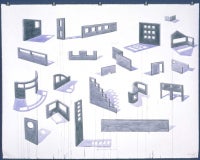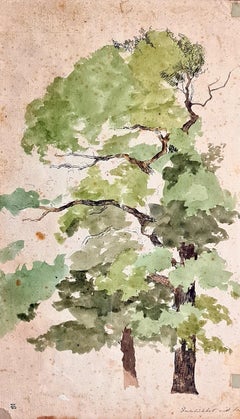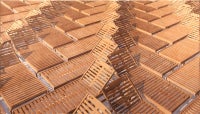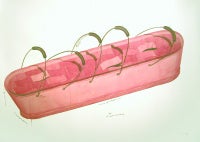Los Carpinteros Art
1
1
1
Overall Height
to
Overall Width
to
1
1
1
6,910
3,240
2,514
1,217
1
1
1
Artist: Los Carpinteros
El Muro #18
By Los Carpinteros
Located in San Francisco, CA
Category
21st Century and Contemporary Los Carpinteros Art
Materials
Paper, Watercolor
Related Items
Untitled 520, 1980s
By Bob Paul Kane
Located in Quogue, NY
Watercolor on paper
Category
1980s Expressionist Los Carpinteros Art
Materials
Watercolor, Paper
19th Century Danish Drawing and Watercolour Study of a Tree at Indelluket
By Thorald Læssøe
Located in Cotignac, FR
Mid 19th Century watercolour drawing and watercolour study of a tree by noted Danish artist Thorald Læssøe. The work is monogram signed bottom left and there is an annotation in the ...
Category
Mid-19th Century Romantic Los Carpinteros Art
Materials
Watercolor, Pencil, Paper
H 12.21 in W 18.12 in D 0.79 in
Intérieur Provence, Realistic Figurative original Drawing, Colorful, Interior
Located in AIX-EN-PROVENCE, FR
Coloured Pencils and pastel on Hahnemühle paper - Realistic Figurative original Drawing, Colorful, Interior.
Work Title : Intérieur Provence
Artist : Gabriel Riesnert...
Category
21st Century and Contemporary Contemporary Los Carpinteros Art
Materials
Watercolor, Archival Paper, Color Pencil, Pastel
H 6.3 in W 5.91 in D 0.08 in
Small, Charming, Fauvist Painting Michel Henry French Modernist School of Paris
By Michel Henry
Located in Surfside, FL
Michel-Henry was born in Langres in 1928 and has shown strong passion for drawing since his childhood. Michel-Henry is acknowledged as an important painter in French contemporary art. From 1952 his work has periodically been singled out for France's highest prizes and awards. The French Government, the City of Paris , the Museum of Valence , Bogota and the Museum of Alencon are among the distinguished institutions who have acquired his work for their permanent collections.
Born in Langres in 1928 the aspiring artist attended the Ecole Nationale Superieure des Beaux-Arts in Paris. He later studied with Narbonne , Georg, Chapelain-Midy and Legueult. In 1957 he became a member of the House of Descartes in Amsterdam and the following year was named member of the Casa Velazquez in Madrid , honors which are exceptional for a young painter.
He is a member of the Salon d'Automne as well as a member of its jury, he also exhibits in the Salon de la Société Nationale des Beaux-Arts, the Salon Comparisons, and the Salon Terres Latines. In 1976 he shared in the honor of presenting the Salon d'Automne exhibition in Japan .
Michel-Henry blends delicate tones and strong and fascinating accents into his compositions of flower still life, landscapes and marines. An avid interest in nature is the predominant quality of his luminous works.
As a French artist whose works are known internationally, Michel-Henry over a period of twenty eight years has earned the status of a goodwill ambassador in a universal world of cultural exchanges. For his dedication and unselfish contributions to art and artists from all lands he was honored by his country by being awarded the prestigious - la Croix de Chevalier de la Légion d'Honneur - on January 1, 1981 by the French Minister of Culture Mr. Jean Philippe Lecat. Michel Henry exhibited at prestigious galleries in Paris (Avenue Matignon) and New York (Madison Avenue) alongside such artists as Pablo Picasso, Fernand Leger, Armand Guillaumin, Maurice Utrillo and Claude Venard. He is part of School of Paris artists that included Marcel Cosson, Jean Jansem, Leni-Dael, Raoul Dufy, Claude Salomon, Michel Kouliche...
Category
1960s Modern Los Carpinteros Art
Materials
Gouache, Paper
Always Roses
Located in THOMERY, FR
Gouache on paper sent from France rolled in a tube. The work of Linda Clerget is realized in an impressionist style à la gouache alla prima. The colors are broken and worked in the f...
Category
21st Century and Contemporary Fauvist Los Carpinteros Art
Materials
Gouache, Archival Paper
Delicate rose Watercolor painting Flowers Aquarelle
Located in Zofingen, AG
Painting with a rose. Watercolor. The painting with scarlet rose on a table.
.
Watercolor painting with a scarlet garden rose on a pastel background. In this artwork, I talk about th...
Category
2010s Impressionist Los Carpinteros Art
Materials
Paper, Watercolor
H 15.36 in W 10.63 in D 0.04 in
Grand Bouquet Et Fruits Devant La Fenêtre À Paris By Marc Chagall
By Marc Chagall
Located in New Orleans, LA
Marc Chagall
1887-1985 Russian
Grand bouquet et fruits devant la fenêtre à Paris
(Large bouquet and fruits in front of the window in Paris)
Stamped with signature “Marc Chagall" (...
Category
20th Century Post-Impressionist Los Carpinteros Art
Materials
Paper, Pastel, Gouache
H 55 in W 40.75 in D 3 in
Pre-Raphaelite, British turn of the 20th C, 'Olive branch', by Evelyn de Morgan
By Evelyn de Morgan
Located in Petworth, West Sussex
Evelyn De Morgan (British, 1855 – 1919)
An olive branch
Watercolour on paper
9 x 7.1/2 in. (22.8 x 19 cm.)
Provenance: The Clayton-Stamm Collection. ...
Category
Late 19th Century Pre-Raphaelite Los Carpinteros Art
Materials
Watercolor, Paper
Autumn flame Watercolor painting Aquarela Red and grey colors
Located in Zofingen, AG
Painting with flowers for living room. Painting in red colours for bedroom. Painting for classic interior. Impressionistic painting.
A watercolor painting with red grape leaves. Ric...
Category
2010s Impressionist Los Carpinteros Art
Materials
Watercolor, Paper
H 22.05 in W 14.97 in D 0.04 in
Garden Flowers
By Charles Demuth
Located in New York, NY
Charles Demuth was one of the most complex, talented, and deeply sensitive artists of the American modern period. Whether he was painting floral still lifes, industrial landscapes, or Turkish bathhouses, art was, for Demuth, fraught with personal meaning. A fixture of the vanguard art scene in New York, Demuth navigated the currents of Modernism, producing some of the most exquisite watercolors and original oil paintings in twentieth-century American art.
Demuth was born in Lancaster, Pennsylvania, the only child of a well-to-do family. He had an awkward and introverted childhood shaped by a childhood illness, Perthes, a disease of the hip that not only left him permanently lame, but, as part of the “cure,” bedridden for two years in the care of his mother. This long period of incapacitation had a deep impact on Demuth, who came to see himself as an invalid, an outsider who was different from everyone else. It was perhaps during this period of indoor confinement that his keen interest in art developed. Several relatives on his father’s side had been amateur artists, and, following his convalescence, his mother encouraged his artistic pursuits by sending him to a local painter for instruction. The majority of his early pictures are of flowers, a subject for which Demuth maintained a lifelong passion.
Following high school, Demuth enrolled at the Drexel Institute of Art in Philadelphia, a school renowned for its commercial arts program. He advanced through the program rapidly, and, in 1905, at the encouragement of his instructors, he began taking courses at the Pennsylvania Academy of the Fine Arts. The two leading teachers then at the Academy were William Merritt Chase and Thomas Anshutz. Anshutz, himself a former student of Thomas Eakins, was well liked by his students, and is best known as the teacher of Robert Henri, John Sloan, and several of the other artists of the Ashcan School. Demuth, too, adopted a similar idiom, working in a controlled, realistic manner while at the Academy, where he remained until 1910.
In 1907, Demuth made his first trip to Europe, staying in Paris. He spent time on the periphery of the art scene composed of the numerous American artists there, including John Marin and Edward Steichen. He returned to Philadelphia five months later, and immediately resumed courses at the Academy. Despite his introduction to advanced modern styles in Europe, Demuth’s work of this period retains the academic style he practiced before the trip. It wasn’t until he had summered at New Hope, Pennsylvania, in 1908 and 1911, that his style began to evolve. New Hope was a prominent American Impressionist art colony whose members were largely affiliated with the Pennsylvania Academy. Demuth dropped the conservative tone of his style and adopted a freer and more colorful palette.
Although he remained based in Philadelphia, Demuth frequently went to New York during this period. Many of the same American artists of the Parisian art scene Demuth had encountered on his earlier European trip now formed the nucleus of New York’s avant-garde, which centered around Alfred Stieglitz’s 291 gallery. It wasn’t long before Demuth began to apply modernist-inspired strategies to his work. He was particularly influenced by the watercolor work of John Marin, also a former student of Anshutz, whose bold use of color in the medium Demuth freely adapted into looser washes of color.
In 1912, Demuth again left for Paris, this time studying in the Académie Moderne, Académie Colorossi, and Académie Julian. In Paris Demuth met the American modernist Marsden Hartley. Hartley, a principal figure in the expatriate art circle, acted as a mentor to Demuth, and introduced him to the wide array of modern styles currently practiced in Europe. Hartley also introduced Demuth to many of the members of the Parisian avant-garde, including Gertrude Stein. Demuth was an aspiring writer, and he spent many hours in conversation with Stein. He wrote extensively during this period, and published two works shortly after his return to America. He also developed an interest in illustrating scenes from literary texts. From 1914 to 1919, Demuth produced a series of watercolors of scenes from books such as Emile Zola’s Nana and Henry James’s The Turn of the Screw.
Upon his return to America, Demuth settled in New York. In 1914, Demuth had his first one-man show at Charles Daniel’s gallery, which promoted emerging modern American artists, including Man Ray, Rockwell Kent, Yasuo Kuniyoshi, Stuart Davis, and Max Weber. Demuth drew closer to the artistic vanguard in New York, becoming friends with many in the Stieglitz and Daniel circles, including Georgia O’Keeffe, Marcel Duchamp, Carl Van Vechten, and Edward Fiske.
New York’s cosmopolitan atmosphere and active nightlife appealed greatly to Demuth. In a sketchy style well suited to watercolor, he painted many vaudeville and circus themes, as well as nightclub, café, and bathhouse scenes. Often with Duchamp, Demuth took part in an urban subculture replete with nightclubs, bars, drugs, and sexual permissiveness, which, for a homosexual artist like himself, allowed room for previously unattainable personal expression. Demuth’s pictures of sailors, bathhouses, and circus performers embody a sensual and sexual undercurrent, expressing the artist’s sense of comfort and belonging in the bohemian subculture of New York.
Simultaneously, Demuth deepened his interest in floral pictures, painting these almost exclusively in watercolor. His style evolved from the broad color washes of his earlier pictures to more spare, flattened, and sinuous compositions, inspired by the drawings of Aubrey Beardsley and other artists of the Aesthetic Movement. Demuth’s flower watercolors are moody and atmospheric, sensuous and elegant, introspective and yet full of expressive power. Moreover they are beautiful, and are unequivocally among the finest still lifes in American art. Despite numerous subsequent artistic undertakings that led him in a variety of directions, Demuth never stopped painting flower pictures, ultimately adding fruits and other still-life objects to his repertoire.
In 1916, Demuth began to develop a style later known as Precisionism, a form of landscape painting infused with Cubism, in which space is divided into precisely drawn geometric regions of color. Demuth first began to paint the landscape in an appropriated Cubist mode while on a trip with Hartley to Bermuda. In these early landscapes, in which the curvilinear forms of trees intersect the geometrically articulated architectural forms, Demuth explored ideas that shaped the future development of modernism in America.
The full realization of Demuth’s explorations came after his return to America in 1917, when he turned his attention to industrial subjects. These works derive from a “machine aesthetic,” espoused by New York artists such as Francis Picabia, Joseph Stella, Albert Gleizes, and Duchamp, by which artists viewed machines as embodying mystical, almost religious significance as symbols of the modern world. Rather than painting the skyscrapers and bridges of New York as did most of his like-minded contemporaries, Demuth returned to his home town of Lancaster, where he painted factories and warehouses in a Precisionist idiom. The titles for these pictures are often contain literary references, which serve as clues for the viewer to aid in the decoding of the artist’s meaning.
In 1923, Demuth planned a series of abstract “poster portraits” of his friends and contemporaries in the New York art and literary scene. In these “portraits,” Demuth combined text and symbolic elements to evoke the essential nature of his sitters’ distinguishing characteristics. In this fashion, he painted portraits of such artists as Georgia O’Keeffe, John Marin, and Arthur Dove. His most famous poster portrait, I Saw the Figure 5 in Gold...
Category
20th Century American Modern Los Carpinteros Art
Materials
Paper, Watercolor
Swim, Summer Fresh Painting on Paper, Word Art Pastel Tones Typography in Purple
By Ryan Rivadeneyra
Located in Barcelona, ES
"Swim is a hand-painted acrylic painting on high-quality 300g paper by artist Ryan Rivadeneyra. The hand-drawn render is reminiscent and inspired by the word art that Ed Ruscha produ...
Category
2010s Pop Art Los Carpinteros Art
Materials
Ink, Archival Ink, Sumi Ink, Watercolor, Archival Paper, Acrylic
Horizontal Still-Life: Flowers in a vase
By Béla Czóbel
Located in Chicago, IL
Signed, lower right
Provenance:
Acquired from the artist
Exhibited:
Béla Czóbel: Paintings, Watercolors, Drawings, R. S. Johnson Fine Art, Chicago, 1996: no. 28.
Category
1960s Expressionist Los Carpinteros Art
Materials
Paper, Charcoal, Watercolor
Previously Available Items
Tumbonas de Madera II
By Los Carpinteros
Located in San Francisco, CA
Category
Los Carpinteros Art
Materials
Watercolor, Paper
Rio (Los Encantos de la colectividad)
By Los Carpinteros
Located in San Francisco, CA
Category
Los Carpinteros Art
Materials
Watercolor, Paper
Los Carpinteros art for sale on 1stDibs.
Find a wide variety of authentic Los Carpinteros art available for sale on 1stDibs. You can also browse by medium to find art by Los Carpinteros in paint, paper, watercolor and more. Not every interior allows for large Los Carpinteros art, so small editions measuring 102 inches across are available. Customers who are interested in this artist might also find the work of Lidzie Alvisa, Alain Pino, and Renelio Marin.




